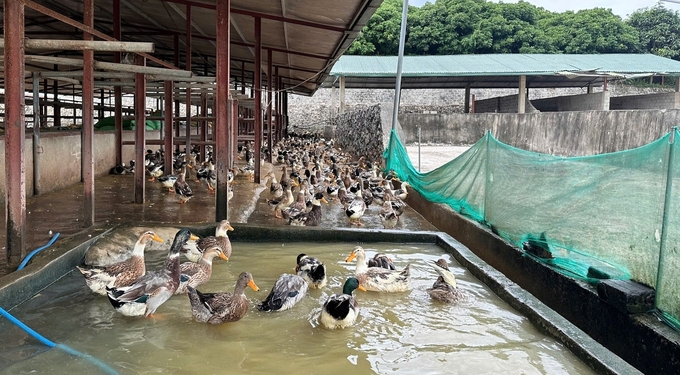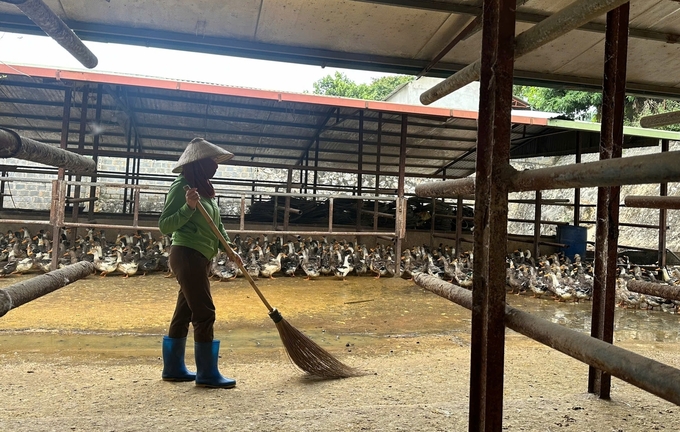Farmers in Son La are developing a model of native mallard ducks, thanks to economic efficiency without taking much time and care costs.

Ms. Nguyen Thi Tam, residing in village 6 (Chieng Mung commune, Mai Son district) has been successful with the model of raising the native blue-necked duck breed of Son La province.
This duck breed is famous for its good resistance and adaptability to harsh natural conditions. This duck breed is favored by many consumers because of its delicious, firm meat and is disease-free. The identifying characteristics are usually a retracted neck, small, short legs, and a striped neck and head.
The selling price of the product ranges from 100,000 – 110,000 VND/kg. Ms. Tam’s duck products always have a stable output thanks to regular orders from restaurants in and outside Son La province.
Vaccination is focused on according to the recommendations of veterinary staff. Before re-flocking, newly hatched ducks are vaccinated against hepatitis at 3 days old, and vaccinated against cholera at 7 days old; vaccinated against avian influenza at 15 days old; vaccinated against cholera at 21 days old; and vaccinated against avian influenza at 45 days old. After vaccination, the flock has good resistance, minimizing the risk of disease and developing rapidly.
The price of ducklings imported from hatcheries ranges from 17,000 – 18,000 VND per duck. After about 3.5 to 4 months of raising, her ducks can reach a weight of 1.7 – 1.8 kg, which is the right time to sell and ensure the best meat quality.
To ensure the quality of livestock farming in a biosafety direction, Ms. Tam strictly implements the nutritional process for ducks. The ducks’ food is mainly corn, rice bran and green bean powder, natural foods that help ducks grow healthily, mixed together and then put into the pellet press.
Every day, the ducks are fed two meals in the morning and evening, with the total cost of food for one duck being about 60,000 – 70,000 VND.

Not only focusing on nutrition, the work of maintaining the hygiene of the barn is also ensured. Every 10 days, she cleans the barn, using lime powder to sprinkle around the floor and the barn to kill bacteria. Then, she washes it with water, ensuring no bad smell and always keeping the living environment of the ducks airy and clean. The water tank is 20 – 30cm high and is also arranged reasonably so that the ducks can bathe and drink water every day, ensuring the best health for the flock.
Another important factor in Ms. Tam’s farming model is the thorough investment in the barn. She has invested more than 500 million to build 5 barns with full roofs to avoid rain and wind on an area of 2,500m² since 2022, the barns are divided into areas according to each stage of the ducks’ development, from young to adulthood. This helps her easily manage and care for the ducks effectively, while optimizing the usable area.
Thanks to the scientific breeding process, Ms. Tam has a stable income from selling commercial ducks. On average, each month, she sells 200 to 300 ducks according to orders from restaurants in and outside Son La province, earning a profit of 10 – 13 million VND per month.
To prepare for this year’s Tet holiday, Ms. Tam has planned to sell more than 500 ducks, and the herd restoration work is carried out monthly, with the expectation of spreading more duck breeds to the national market.
According to Mr. Nguyen Ngoc Toan, Head of the Department of Animal Husbandry, Veterinary and Fisheries of Son La: “The native green-necked duck breed is a new direction in the breeding work of people in Son La, thanks to its good resistance and delicious meat quality, besides, the care techniques are quite simple and do not take much time or cost. The Department is planning to support people to continue to develop this duck breed widely in the area.”
Duc Binh
